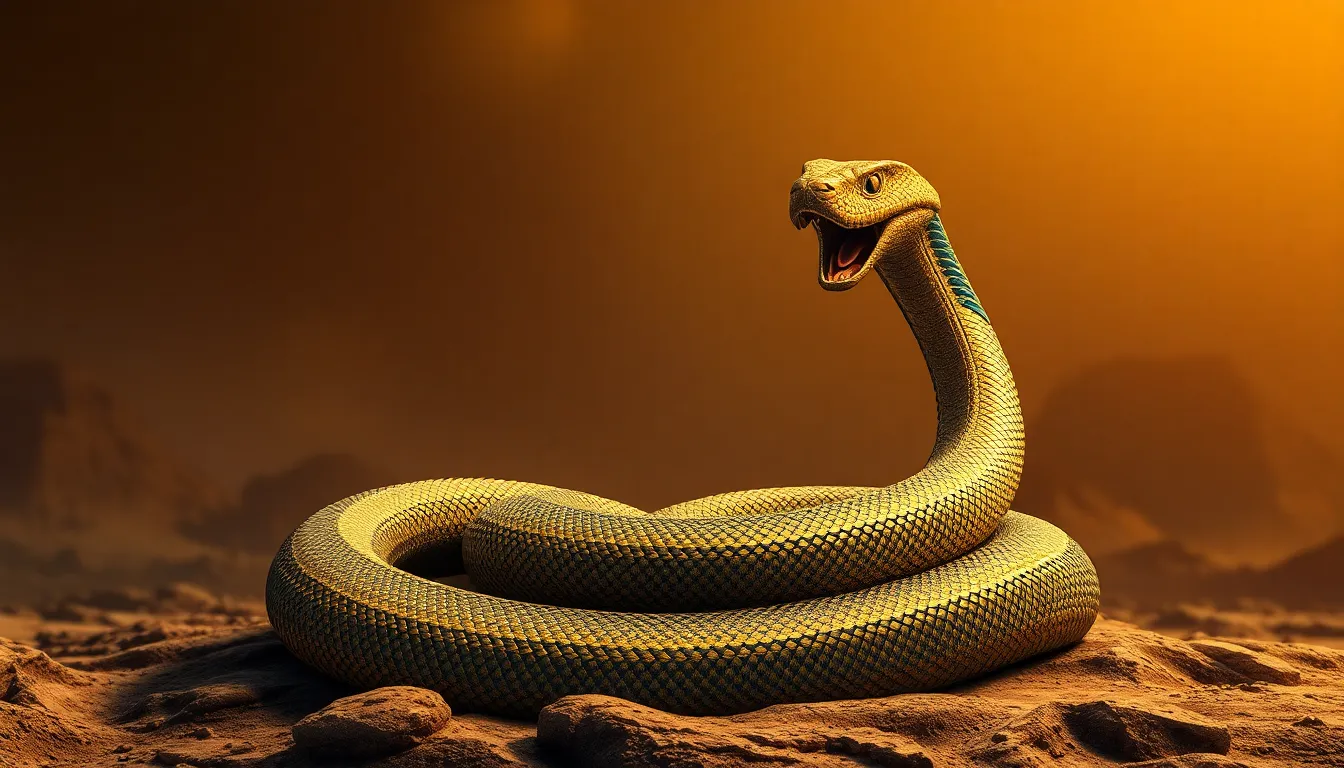The Geography of the Sacred Cobra: Myths of Wadjet
I. Introduction to Wadjet
Wadjet, one of the most revered deities in ancient Egyptian mythology, is often depicted as a cobra or a woman with a cobra on her head. As a symbol of protection and royalty, Wadjet played a crucial role in the spiritual and political life of ancient Egypt, particularly as the protector of the pharaohs. The sacred cobra, associated with her, signifies both danger and safeguarding. This article aims to explore the geographical and mythological aspects of Wadjet, detailing her significance in ancient Egyptian culture.
II. The Sacred Cobra: Symbolism and Representation
The sacred cobra, or Uraeus, is a powerful symbol in Egyptian iconography and mythology. It embodies various meanings, including:
- Protection: The cobra is often seen as a guardian against evil, representing a fierce protector of the pharaohs.
- Royalty: The Uraeus was worn on the crowns of pharaohs, signifying their divine authority and connection to Wadjet.
Wadjet’s iconography can be found in numerous ancient artifacts, including:
- Statues depicting her as a cobra or a woman with a snake.
- Reliefs in temples and tombs showcasing her protective role.
In funerary practices, the cobra was believed to provide protection in the afterlife, ensuring safe passage and guarding the deceased against malevolent forces.
III. Historical Geography of Wadjet’s Worship
The worship of Wadjet was concentrated in specific regions of ancient Egypt, notably:
A. Key locations of Wadjet worship in ancient Egypt
- The city of Buto: Located in the Nile Delta, Buto was considered the center of Wadjet’s worship and was associated with her mythology.
- Delta region: The fertile lands of the Delta were significant for agriculture and trade, contributing to her veneration as a protector of prosperity.
Geography played a crucial role in the spread of Wadjet’s worship. The accessibility of the Delta region allowed for the exchange of cultural and religious practices, enhancing her influence across ancient Egypt. Archaeological excavations in Buto and surrounding areas have revealed temples and artifacts dedicated to her worship, underscoring her importance in the spiritual landscape of the time.
IV. Myths and Legends Surrounding Wadjet
Wadjet’s mythology is rich with stories that illustrate her significance in the ancient Egyptian worldview. Some notable myths include:
A. Origin myths of Wadjet and her role in the creation narrative
Wadjet is often linked to the creation myth, where she is seen as a primordial goddess responsible for creation and protection. Her emergence from the primordial waters symbolizes the birth of life and order.
B. Tales of Wadjet’s protection of the pharaohs
Wadjet was believed to actively protect the pharaohs in battle and in governance. Many legends tell of her fierce defense against enemies, ensuring the stability and continuity of the kingdom.
C. Influence of Wadjet in the larger pantheon of Egyptian gods
As a significant deity, Wadjet’s influence extended to other gods and goddesses, often being invoked in conjunction with deities like Horus and Osiris, further solidifying her role in the Egyptian pantheon.
V. The Relationship Between Wadjet and Other Deities
Wadjet’s interactions with other deities reveal her complexity and multifaceted nature:
A. Wadjet and her connection to other goddesses, such as Isis and Hathor
Wadjet is often associated with Isis and Hathor, sharing attributes of motherhood, protection, and fertility. Together, they represent a nurturing aspect of divinity.
B. The duality of Wadjet as both a nurturing and fierce protector
While Wadjet is revered as a motherly figure, she is also a fierce warrior, embodying the dual nature of protection and ferocity.
C. Comparative analysis with similar deities in other cultures
Similar protective deities can be found in other cultures, such as the Greek goddess Athena and the Hindu goddess Durga, who also embody both nurturing and warrior-like qualities.
VI. The Sacred Cobra in Egyptian Rituals and Festivals
A. Rituals dedicated to Wadjet and the sacred cobra
Rituals honoring Wadjet often involved offerings of food, incense, and symbolic items, performed to seek her protection and blessings.
B. Festivals celebrating Wadjet and their geographical significance
Annual festivals held in Buto celebrated Wadjet, featuring processions, music, and dance, highlighting the goddess’s importance in local culture and community.
C. The impact of these rituals on local communities
These festivals fostered community bonding, ensuring the continuity of cultural practices and reinforcing the shared beliefs among the people.
VII. Modern Interpretations and Legacy of Wadjet
A. How Wadjet is perceived in contemporary culture and spirituality
Today, Wadjet is often invoked in modern spiritual practices, representing protection and empowerment, particularly among those interested in ancient wisdom.
B. The role of Wadjet in modern Egyptology and tourism
Wadjet has captured the interest of Egyptologists and tourists alike, with many seeking to understand her significance through visits to archaeological sites and museums.
C. Preservation of Wadjet’s legacy in modern art and literature
Wadjet’s image continues to inspire contemporary artists and writers, reflecting her enduring legacy as a symbol of strength and protection.
VIII. Conclusion: The Enduring Symbolism of Wadjet
Wadjet’s geographical and mythological significance illustrates the deep connections between ancient beliefs and the landscapes of Egypt. Her legacy as a protector of the pharaohs and a symbol of royalty has persisted throughout history. Preserving these ancient myths allows modern society to appreciate the cultural geography that shaped them. The sacred cobra remains an enduring symbol of power and protection, influencing both ancient and modern contexts.




